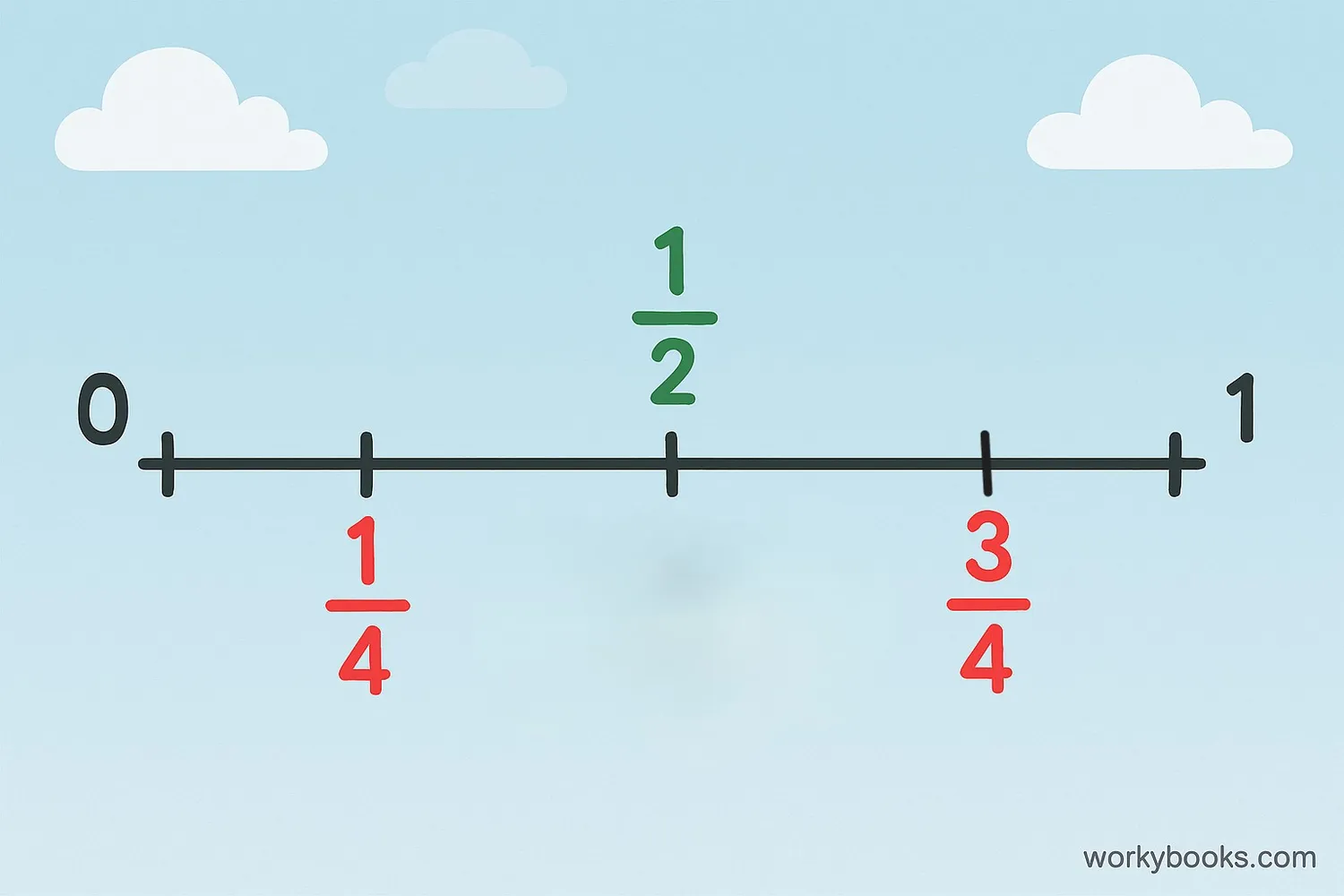Fraction Number Line - Definition, Examples, Quiz, FAQ, Trivia
Learn to represent, compare, and understand fractions using number lines with visual examples and practice activities
What is a Fraction Number Line?

A fraction number line is a visual representation that helps us understand fractions as numbers. Just like regular number lines show whole numbers in order, fraction number lines show fractions in order between whole numbers.
Fraction number lines have two important parts:
Numerator: The top number in a fraction that shows how many parts we have.
Denominator: The bottom number that shows how many equal parts the whole is divided into.
On a fraction number line, the distance from 0 to 1 represents one whole. This whole is divided into equal parts based on the denominator. For example, if we're showing fourths, the space between 0 and 1 is divided into 4 equal parts.
Key Concept
The denominator tells us how many equal parts to divide the number line between 0 and 1.
How to Represent Fractions on a Number Line
Representing fractions on a number line follows these steps:
Step 1: Draw a line and mark 0 on the left end and 1 on the right end.
Step 2: Look at the denominator (the bottom number) of your fraction. This tells you how many equal parts to divide the line into.
Step 3: Make equally spaced marks between 0 and 1 based on the denominator.
Step 4: The numerator (top number) tells you how many of those parts to count from 0.
Let's practice with an example:
To plot 3/4 on a number line:
- Divide the line between 0 and 1 into 4 equal parts (because denominator is 4)
- Count 3 marks from 0 (because numerator is 3)
- Place a point at that location
Interactive Example: Plotting 3/4
Remember
The denominator determines how many equal parts we divide the number line into, and the numerator tells us how many of those parts to count.
Comparing and Ordering Fractions on a Number Line
Number lines are excellent tools for comparing fractions. When fractions are placed on a number line, it's easy to see which is larger or smaller because fractions to the right are larger than fractions to the left.
Comparing fractions with the same denominator:
When denominators are the same, compare numerators. For example, 3/5 > 2/5 because 3 > 2.
Comparing fractions with different denominators:
When denominators are different, use a number line to visualize their positions. For example, to compare 1/2 and 1/3:
- Divide the number line into halves: mark 1/2 at the middle
- Divide the same number line into thirds: mark 1/3 and 2/3
- You'll see that 1/2 is to the right of 1/3, so 1/2 > 1/3
Finding equivalent fractions:
Equivalent fractions are different fractions that represent the same value. On a number line, they occupy the exact same position. For example, 1/2, 2/4, and 3/6 all point to the same location on the number line.
Comparing 1/2, 1/3, and 1/4
Comparison Tip
When comparing fractions, if they're on a number line, the fraction farthest to the right is the largest.
Real-World Examples

Fraction number lines are used in many real-world situations. Let's look at some examples:
Example 1: Measuring length with a ruler
Rulers show inches divided into fractions (halves, quarters, eighths, etc.). When you measure something that's 3½ inches long, you're using a fraction number line!
Example 2: Reading a measuring cup
Measuring cups show fractions of a cup. When you see the ½ cup mark, that's a fraction on a measurement "number line."
Example 3: Understanding time
A clock face is a circular number line. 15 minutes is ¼ of an hour, 30 minutes is ½ of an hour, and 45 minutes is ¾ of an hour.
Example 4: Sports measurements
In track and field, runners might complete ¾ of a lap. On a number line representing one lap, ¾ would be three-quarters of the way from the start.
Real-World Connection
Fraction number lines help us understand measurements in cooking, construction, time, and many other everyday situations.
Fraction Number Line Quiz
Test your understanding of fraction number lines with this 5-question quiz. Choose the correct answer for each question.
Frequently Asked Questions
Here are answers to common questions about fraction number lines:
Fraction Trivia
Discover interesting facts about fractions and number lines:
Ancient Fractions
The ancient Egyptians used fractions as early as 1800 BC, but they mainly used unit fractions (fractions with 1 as the numerator). They would write other fractions as sums of unit fractions.
Decimal Connection
Every fraction can be represented as a decimal on a number line. For example, 1/2 is 0.5, 1/4 is 0.25, and 1/3 is approximately 0.333. This shows the connection between fractions and decimals.
Measurement Fractions
The inch is typically divided into fractions rather than decimals in the United States. Standard divisions are halves, quarters, eighths, sixteenths, and sometimes even thirty-seconds or sixty-fourths of an inch!
Musical Fractions
In music, note values are based on fractions of a whole note. A half note is half the duration of a whole note, a quarter note is one quarter, and so on. This is a practical application of fractions in the arts.





